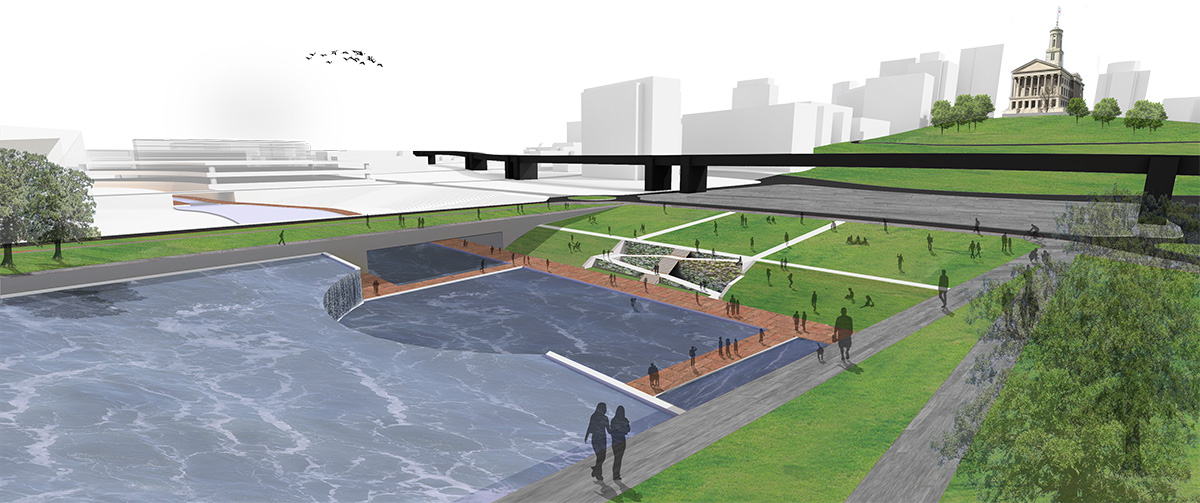Shengzhen Super City master city plan proposal (2014)
Shenzhen is rapidly growing with emerging industries of new energies, internet information technology and culture. The project site, planned to attract those industries and strengthen the city’s CBD function, has unique urban potentials. Regionally, it is expected to have excellent mobility systems (High-speed railway and multiple subway lines), recreational attractions (Shenzhen Bay Waterfront, Happy Valley), and upscale residential neighborhoods. However, it lacks local micro-scale mobility connections among those regional location potentials. To sustain Shenzhen’s growth, the project reshapes the city’s new economic geography with a new mobility system and the iconic Blooming City center.
Lick Branch Eco-stream (2014)
The Lick Branch EcoStream is a multipurpose infrastructure system disguised as an iconic public park for tourists and locals of Nashville. It is an interwoven network of active urban landscapes, historical connections, and water infrastructure. Essentially, the Sulphur Dell development area is ubiquitously composed of three elements: History, Health, and the Environment.
History
Currently, the music city bike path that runs through the site is built above a running tributary that discharges water into the Cumberland River. This tributary, Lick Branch Stream, has a major historical significance to Nashville. Sulphur Springs Bottom and Lick Branch Stream were essential to the origins of Nashville. The relevance of this site to Nashville’s history justifies the importance to invest in this location.
Health
Public health is a major component of this proposal. Along the EcoStream and throughout the development site are lanes exclusively for pedestrian and bicyclists. Pedestrians also have access adjacent to the water, making exercise along the EcoStream both desirable and unique. In regards to food access, we propose a rooftop farm above the Sulphur Dell Parking Lot and public markets to provide options for healthy food.
Environment
Our proposal addresses several concerns with the environment, with Flood Control and Stormwater Management as the primary concern. The tributary that discharges water into the Cumberland River is redirected and cleaned by biofiltration as it flows through the EcoStream. The treated water is eventually discharged back into the Cumberland. The system also addresses flooding when the Cumberland water level reaches 35 feet above the river’s bottom. In case of extreme flooding, there is an emergency discharge pipe that redirects floodwater westward beyond city limits.
With these three elements in mind, the conceptual vision of the Lick Branch EcoStream is to integrate and build upon current plans for downtown, further making Nashville a major destination. The proposal is to create and connect anchors, ultimately creating an experiential loop. This “loop” will connect Downtown Nashville’s government, shopping, and arts and entertainment districts, using 5th Ave, 3rd Ave, and the Cumberland riverfront as connectors. The goals of our proposal are synonymous with the NashVitality program, which promotes a healthy, active, and green lifestyle in Nashville.
The Lick Branch Eco-Stream will be the first piece in completing this vision for Nashville. It will address some of the most pressing issues in this locale and the history behind this location helps to justify the investment as it will resurface the origin of Nashville. It will add to the successful offerings surrounding its Capitol Hall, such as the popular Bicentennial Mall State Park. The impetus created by the recent waterfront development south of the site, the growth of Germantown to the north and the incoming investment of the baseball stadium, encourages this development proposal. Building upon these developments to increase their impact on Nashville and the State of Tennessee, the project will further improve the health, environment and economic well-being of its citizens, while also increasing the city’s profile as both a major tourist destination and place to live.







Bamboo Forest (2013)
Using bamboo as sustainable material is main idea to start an initial concept design and my team integrates with traditional Asian architectural construction ways, not using nail joint. There are big three design strategies: 1. Economic sustainability 2. Social sustainability 3. Asian architectural wisdom in sustainability
This complex is mix-use purpose to provide residential units with commercials and public open space for local communities. One of sustainable strategies is construction period as 10 years long term using bamboo's recognized feature as fast growing.
Mass Study
Time Phase Construction Strategy























